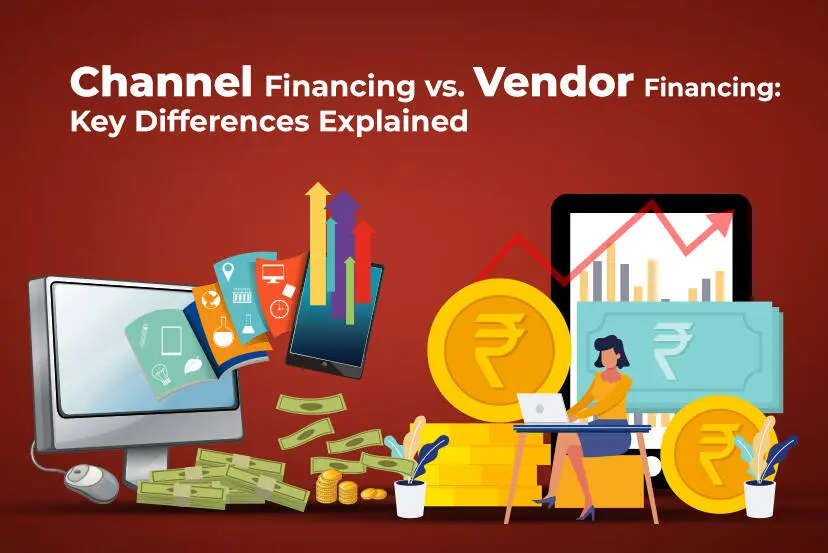The supply chains continue to become more complex and faster, while time is of the essence. As a result, smarter and more strategic solutions emerge to keep businesses liquid without interrupting operations, as businesses turn to them. In that respect, the two popular financial solutions are channel financing and vendor financing. Although both are useful for managing working capital, they play different roles to the benefit of different players in the trading ecosystem. Understanding how they work and what sets them apart empowers businesses to make more informed and effective financing decisions.
What Is Channel Financing?
Channel financing is a short-term credit extended to the company’s distribution arrangement of dealers, wholesalers, and retailers by a financial institution. It allows these channel partners to buy items in advance without putting pressure on their cash flow. The credit is normally given on the seller’s invoice and is repaid within an agreed period of credit.
This financing model ensures that distributors and dealers get to experience smoother activities and sufficient stock even during seasonal cash flow fluctuations. For manufacturers and large suppliers, channel financing enables faster payments and better relationships with the dealers.
What Is Vendor Financing?
Vendor financing is where a seller (or vendor) offers delayed payments to a buyer for selling goods or services. This form of financing normally includes an agreement, and the vendor acts like a lender and lets the buyer pay in instalments, at times, with interest rates.
Vendor financing is typical for capital-intensive purchases such as machines, technology solutions, or a set of infrastructure undertakings, when the buyers require time for generating returns before they repay costs.
Who Benefits the Most?
In channel financing, the major beneficiary is the distribution partner; the dealers and retailers have access to an immediate source of funds to acquire stock and follow customers’ demands. This enhances their purchasing power while not impacting their working capital.
On the other hand, the vendor financing offers an advantage to buyers because they can purchase large assets or inventories without paying an initial amount. It also supports vendors to increase their sales and establish long-term relationships with customers through flexible payment modes.
Key Differences in Structure
The main structural difference is who provides the credit. In channel financing, a bank or an NBFC would step in to borrow from the seller into its channel partner. The financial institution becomes at risk, and the seller receives the payment at an earlier date.
In the case of vendor financing, it is the seller who finances the buyer. There is no participation of an external financial institution in most cases. This exposes the seller financially but can also create a competitive advantage.
Credit Risk Management
In channel financing, the financial institution that bears the credit risk is. The institution assesses the creditworthiness of the distributor before releasing funds. This makes the process secure for the seller, who receives the money instantly and doesn’t need to take the repayment risk.
The vendor takes credit risk in the case of vendor financing. In case the buyer fails to pay as agreed or delays it, the vendor may have problems with cash flow. Due to this, vendor financing is given mostly to trusted clients or accompanied by strong contractual agreements.
Repayment Terms and Interest Rates
Payment in channel financing is usually made after intervals of 30, 60 or 90 days, depending on the terms agreed upon with the financial institution. Carrying the burden of interest is done by the buyer (distributor/dealer), and most times it is competitive in nature as there is bank and NBFC involvement.
In vendor financing, interest rates may change based on the vendor’s policies and the creditworthiness of the buyer. Some vendors might even provide zero-interest terms as an incentive for bulk sales or a long-term contract.
Use Cases and Industries
Channel financing is most popular in the sectors that have extensive distributional networks, such as FMCG, electronics, and auto parts, where dealers require consistent stock availability. It improves sales velocity and builds the overall supply chain.
Vendor financing is better suited for B2B sales in the form of costly capital goods or software, and is used whereby buyers would require payment terms to manage their ROI. This model is applied widely in industries such as manufacturing, IT, and infrastructure.
The Best Fit for Your Business
Although channel financing and vendor financing both aim to ease the cash flow and achieve better business relations, they are quite different in structure, risk, and use cases. Channel financing is a better fit for businesses that use distributors to sell their products, and need faster payments without shouldering the costs. Vendor financing is, in turn, also suitable for sellers who are selling high-ticket items to buyers with payment terms. Knowledge of the differences enables businesses to choose the appropriate model for their financial strategy.
Credlix enables exporters and supply chain businesses with invoice-backed working capital, such as channel finance. Through the provision of quicker payments and a more seamless cash flow, Credlix helps both buyers and sellers to handle trade effectively. Businesses can confidently venture into wider operations without worrying about the disruption of their chain of supplies. This happens since the terms of repayment are flexible, disbursals are prompt, and there is no need for collateral.
Are you a rising distributor or a vendor who wants to provide better terms? Well, Credlix streamlines your cash flow to allow you more room to grow.





